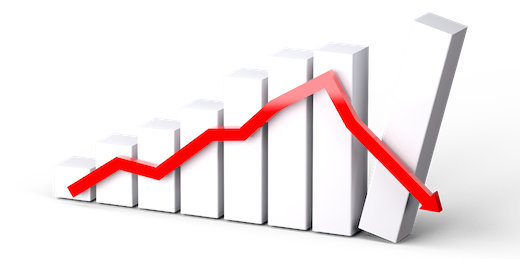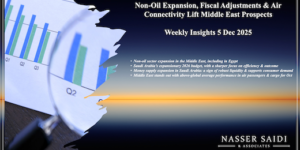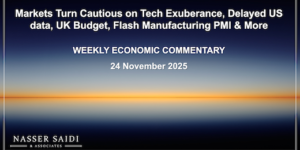Markets
Global equity markets were mostly down on the sudden souring and shift in US-China trade talks, which resulted in Trump raising tariffs on USD 200bn of Chinese goods from 10% to 25% and China pledging to retaliate (our Media Section covers more details). Though at the end of trade negotiations on Fri both sides sounded optimistic (Steven Mnuchin calling it “constructive discussions” and Liu He stating talks had gone “fairly well”), the S&P 500 posted the heaviest loss since Dec, and in China the market was down 4% for the week. The US yield curve briefly inverted for the first time since Mar (a sustained inversion is a recession signal) and German yields are near 6-week lows. In the region, all markets edged down on Thurs, with most ending in the red over the week. Safe haven assets were popular: investors were buying yen (which strengthened vis-à-vis the dollar), and gold price ticked up. Oil price was slightly down during the week, though increasing geo-political concerns (Iran, North Korea) are likely to weigh in, going forward.
Global Developments
US/Americas:
- US trade deficit touched an 8-month low, dropping to USD 49.4bn in Feb; exports climbed by 1.1% to USD 209.7bn thanks to a surge in shipments of civilian aircraft, passenger cars and medicine while imports were up 0.2% to USD 259.1bn. Goods deficit with China dropped 28.2% to USD 24.8bn (20.2% dip in imports while exports grew by 18.2%).
- Inflation in the US edged up in Apr, rising to 2% yoy (Mar: 1.9%) as prices for petrol and accommodation costs increased. Food prices dipped in Apr, posting the first monthly decline since Jun 2017. Core inflation was up to 2.1% yoy (Mar: 2%). US producer price index remained muted, posting 2.2% yoy in Apr (matching Mar’s reading).
- Initial jobless claims fell by 2kto 228k in the week ended May 4, while the 4-week moving average increased 7,750 to 220,250.
Europe:
- German factory orders dropped by 6% yoy in Mar, though posting a 0.6% mom rise. Fall in domestic orders (-4.2%) was balanced out by a pickup in foreign orders (with new orders from the euro area rising 8.2%). Industrial production unexpectedly increased in Mar, rising by 0.5% mom, asproduction of consumer goods rose 1.1% and output of intermediate goods grew 0.4%.
- The EU Markit services PMI, at 52.8 for Apr, surpassed the preliminary estimate of 52.5; composite final PMI dipped to 51.5 in Apr from Mar’s 51.6.
- Germany’s service PMI rose to 55.7 in Apr (Mar: 55.4), its highest reading since Sep, and hiring was at their fastest rate since Oct 2007. However, manufacturing weakness meant that the German composite PMI was one of the lowest in 6 years, at 55.2 in Apr (Mar: 51.4).
- German exports unexpectedly grew by 1.9% yoy in Mar, and the trade surplus widened to EUR 20bn, up from EUR 18.7bn a month earlier.
- The UK economy rebounded in Q1, with GDP growth up 0.5% (Q4: 0.2%); the manufacturing sector grew at its fastest rate since 1998 (factory output was up 2.2%). Net trade was negative during the period, suggesting that manufacturing sector activity was largely for stockpiling (to cope with Brexit which was scheduled for end-Mar).
- UK’s industrial production increased by 0.9% mom and 1.3% yoy in Mar. Separately, goods trade deficit narrowed to GBP 13.65bn in Mar (Feb: GBP 14.434bn deficit).
Asia Pacific:
- China’s central bank stated that there is no need for easing after the Trump tariff hike, as Chinese economic fundamentals “remain solid” and “China has sufficient leeway and a deep monetary policy toolkit, and so has full ability to deal with [economic] uncertainties”. According to a monetary policy adviser to the PBoC, Friday’s tariff hike would shave only 0.3ppt from China’s growth rate and so the impact was “controllable”. Earlier last week, following Trump’s tweet threatening to raise tariffs, the PBoC freed up CNY 280bn (USD 41bn) of long-term funding for small firms through a targeted cut in the required reserves for rural commercial banks.
- China’s Caixin/ Markit services PMI climbed to 54.5 in Apr, the highest since Jan 2018 and slightly up the 54.4 reading in Mar. Export orders increased the most since the survey began measuring this in Sep 2014.
- China’s exports unexpectedly declined in Apr by 2.7% (Mar: +14.2%) while imports rebounded slightly (+4% vs. Mar’s -7.6%), thereby narrowing trade surplus to USD 13.48bn. China’s trade surplus with the US grew 2.4% yoy to USD 21bn.
- Foreign exchange reserves in China fell by 0.1% mom to USD 3.094trn at end-Apr, largely due to exchange rate fluctuations and changes in asset prices. Banks disbursed CNY 1.02trn (USD 150bn) of new loans in Apr (Mar: CNY 1.68trn). Money supply growth slowed to 8.5% at end-Apr (Mar: 8.6%).
- China’s inflation rose to a 6-month high, touching 2.5% yoy in Apr (Mar: 2.3%), as food inflation picked up by 6.1% (largely as price of pork surged 14.4%). Producer price inflation increased 0.9% yoy – the fastest pace since Dec 2018.
- The Bank of Japan’s meeting minutes revealed members concerns about fading recovery prospects and prolonged low level of interest rates. One of the members was worried about a potential recession given the proposed sales tax hike in Oct amidst soft global demand.
- Japan household spending increased for the 4th consecutive month, rising by 2.1% yoy in Mar. Separately, inflation-adjusted real wages dipped 2.5% yoy in Mar, recording the biggest decline since 2015.
- Indonesia’s GDP expanded by 5.07% yoy in Q1 (shrinking by 0.53% qoq) – dragged down by investment (slowing to 5% in Q1 from 6% the quarter before) and exports slumped (-2.08% yoy).
- Singapore retail sales fell by 1% to SGD 3.8bn in Mar (down 1.5% excluding motor vehicles). Online sales however grew 28% yoy in Mar, up from 15.5% the month before.
Bottom line:Global growth headwinds are back in play – global manufacturing PMI (50.3 in Apr vs Mar’s 50.5) slipped to the lowest since Jun 2016 and the new order inflows is the weakest since 2012. The European Commission downgraded growth forecasts for this year and the next and as the US moves closer to imposing tariffs on all Chinese imports, there remain concerns of a further dip in Chinese growth without further economic stimulus. Coming soon is the May 18 deadline by when the US needs to decide on whether to impose tariffs on imports of autos and auto parts from around the world, including Japan (with whom trade deal negotiations are ongoing). Add to this picture, North Korea’s missiles and Trump’s comments on not ruling out military confrontation with Iran, we seem to be stepping into a week that is bound to be rollercoaster ride for markets and investors.
Regional Developments
- The IMF commended Bahrain on its Fiscal Balance Program, the introduction of VAT and the Voluntary Retirement Schemeas a tool to help contain the wage bill (though urging the need to monitor possible contingent liabilities). The IMF also called for further structural reform including private-sector led inclusive growth as well as a more active privatization plan. (More: https://www.imf.org/en/News/Articles/2019/05/07/pr19146-bahrain-imf-executive-board-concludes-2019-aiv-consultation-with-the-kingdom-of-bahrain)
- Ahead of a potential international bond sale, Bahrain disclosed the receipt of USD 2.3bn from its GCC allies (Saudi, UAE and Kuwait) last year and expectations of another USD 2.28bn this year.
- Last week saw contradicting news reports from Bahrain on subsidy reform: initial reports stated that the Bahraini government had scrapped plans to reform its subsidy system for fear of widespread opposition; only for a later announcement that the government reconfirmed its commitment to subsidy reform and that it would be implemented in coordination with parliament.
- Bahrain plans to increase nationalization in the public sector by more than 95% within 3 years. Currently, expats account for about 16% of the public sector employees.
- PMI in Egypt expanded for the first time in 8 months, with the Apr reading at 50.8 (the highest since Aug 2015) from Mar’s 49.4. The output sub-index increased to 50.8 in Apr (Mar: 49.9) while new exports orders remained below the 50-mark (though rising to 48.9 from Mar’s 46.8).
- Egypt expects to receive the final tranche of about USD 2bn of its IMF loan in July, according to the deputy finance minister.
- Egypt’s planning minister disclosed that the country is expected to grow at 5.8% in Q4 of the 2018-19 financial year, following a 5.6% rise in Q3 (Q3 2017-18: 5.4%).
- Inflation in Egypt eased to 13% in Apr (Mar: 14.2%); in mom terms, urban inflation was up 0.5% down from Mar’s 0.8%.
- Budget deficit in Egypt declined to 5.3% of GDP in Jul 2018-Mar 2019 period, versus 6.2% in the same period a year ago. A primary surplus of EGP 35.5bn (USD 2.07bn) was recorded in the 9-month period (0.7% of GDP) compared to a primary deficit of EGP 7bn (0.2% of GDP) a year ago.
- Egypt’s external debt increased to USD 96.6bn at end-2018 from USD 8bn in 2017, according to central bank data. Foreign debt meanwhile increased by 16.5%.
- Egypt will not be increasing the stock exchange fee (scheduled to take effect on June 1) “to reduce the financial burden on traders”: it will remain at EGP 1.5 per 1000 transactions.
- Egypt sold USD 1bn worth of one-year dollar-denominated treasury bills at an average yield of 3.897%.
- Egypt seeks to raise the proceeds of VAT by 13.9% yoy to EGP 364.7bn in fiscal year 2019-2020, thanks to the expansion of the taxation base as well as improvements in tax allocation. The government aims at boosting its total tax proceeds in the coming fiscal year by 12.7% yoy to around EGP 856.6bn.
- The Egyptian Natural Gas Holding Company estimates the market’s consumption of gas to increase to about 7.3bn cubic feet per day (scf/day) in the fiscal year 2020-21 (from 6.5bn scf/day this year).
- The latest IMF Article IV mission to Iraq concluded that while near term vulnerabilities subsided in 2018, given budget surplus and buildup of reserves, post-war reconstruction had been limited. The IMF also stated that “combating corruption is critical to promote the effectiveness of public institutions and to support private-sector investment and job creation”. (More: https://www.imf.org/en/News/Articles/2019/05/06/pr19142-Iraq-imf-staff-completes-2019-article-iv-mission)
- The IMF, after its second economic review in Jordan, released about USD 166mn in funding to support gradual fiscal consolidation. This brings the total amount disbursed under the Extended Fund Facility to USD 309mn.
- Jordan’s Cabinet approved of several measures to revive the flailing real estate market: this includes lowering the basic price offering of real estate by 20% to be in line with market value, as well as exemption from fees levied on ownership transfer and the consensual parceling out of land for citizens.
- Expat remittances from Kuwait increased by 3.9% yoy to KWD 4.3bn last year, with Q2 witnessing the maximum amount transferred (KWD 1.19bn).
- Lebanon’s draft austerity budget is still in a discussion phase, as strikes continue across the country, including by central bank employees.
- PMI in Lebanon improved to 46.7 in Apr, from Mar’s 46.3, largely due to a continued contraction in output. Also, according to the PMI report, the latest contraction in exports was the softest recorded for nearly a year.
- Lebanon’s government agreed to raise the tax on bank deposit interest payments to 10% from 7% for three years, as part of the draft 2019 budget (which is still under discussion).
- Lebanon’s central bank is preparing a bond debt replacement in Lebanese currency with a lower interest rate, reported Daily Star: this move would cut debt servicing by between LBP 900bn-1.1trn (USD 600-733mn) thereby reducing the budget deficit. The source also stated that an official announcement of this move may not be made.
- Passenger traffic at Beirut’s airport increased by 11.8% yoy to 816,816 persons in Apr.
- Oman’s Bankruptcy & Insolvency Law are expected to be enacted this year, as it is in the final stages of the legislative process, according to the Implementation Support & Follow-up Unit of the Diwan of Royal Court.
- In a recent report, S&P underscored the strength of Oman’s balance sheetwhile cautioning about high economic risks due to its dependence on oil revenues. Compared to Bahrain, “bond yields and credit default swaps already suggest even higher credit risks in Oman”.
- S&P affirmed Qatar’s sovereign ratings with a “stable outlook”, maintaining the view that the country will continue to “effectively mitigate” the economic and financial fallout from the ongoing blockade.
- Saudi Arabia’s “Special Privilege Iqama” system was approved by the Shura Council last week. This would allow for freedom of movement to and from Saudi Arabia without the need for consent from a sponsor in addition to extending family privileges (including obtaining visas for relatives) and owning real estate. There will be 2 types of Iqamas – a permanent residence permit & a temporary residence permit with specific fees.
- Saudi Arabia’s PMI remained steady at 56.8 in Apr (the highest since end-2017), with new export orders rising modestly while growth of new work eased slightly from Mar’s near four-year high. Business confidence towards future output rebounded strongly to one of the highest degrees of optimism over the past five years from a 6-month low in Mar.
- Assets of investment funds in Saudi Arabia increased by 46% yoy to SAR 119.76bn in Q1 2019, according to SAMA. Foreign funds’ assets were up 46.1% yoy and 101.7% qoq to SAR 36.73bn in Q1.
- Non-oil revenue in Saudi Arabia grew by 46% yoy in Q1 2019, supported by gains from “taxes on goods and services” which nearly doubled yoy to SAR 41bn.
- Saudi Arabia plans to build a new amusement park, along with six cinemas and 3 new “entertainment destinations” on a 100-hectare site in the Eastern province (which is home to a population of about 4.9mn).
- The GCC real estate slump is likely to continue given the oversupply in the market and amidst regional tensions, according to a new research report from the Institute of International Finance (IIF). By Dec 2018, real estate prices in the GCC had declined by approximately 20% from peak levels, with an especially sharp fall in the UAE. (chart: https://pbs.twimg.com/media/D6M50ojX4AU5hHD.png)
- Islamic banks in the GCC are expected to remain resilient over the next two years, according to a new S&P report. The ratio of financings to total deposits stood at 92.6% for Islamic banks in S&P’s sample at end-2018 and the funding and liquidity profiles are unlikely to change in 2019-2020.
UAE Focus
- UAE’s PMI increased at the fastest pace since Dec 2017, to post 57.6 in Apr (Mar: 55.7); both output and new orders sub-indices surged – 65.3 and 64.6 respectively (Mar: 63 and 59) and new export orders to a near four-year high. However, the offers of discounts in a competitive market resulted in a 7th consecutive monthly fall in output prices. Business confidence was the highest since the series began seven years ago, given expectations of higher new orders and a positive 12-month outlook for activity: approximately 82% predicted a rise in output over the coming year, in connection with the Expo 2020 event.
- The Dubai Economy Tracker inched up to the highest reading since Feb 2015 – to 57.9 in Apr (Mar: 57.6). The wholesale & retail sector improved to 60.1 – a series record – more due to sharp price discounting and promotional activity than underlying demand, while the travel and tourism sector reading was the 2ndhighest on record (58.8, below Mar’s peak of 59.8). The level of incoming new business increased at the fastest rate since Jan 2015 in Apr (66.6) while new sales growth at wholesalers and retailers hit a new record high (70.8).
- The 6 to 12-month term deposits in UAE banks grew by 3.7% yoy to AED 186.8bn in Q1 2019, as per the central bank statistics.
- The value of Abu Dhabi’s non-oil trade increased 11.5% to AED 35.8bn (USD9.7bn) in Jan-Feb 2019. Re-exports surged by 47% to AED 8.8bn, and imports were up 5.6% while non-oil exports dipped 0.3%.
- Dubai Department of Economic Development announced a 45.4% yoy increase in Instant licenses issued during Q1 to 509. The service – which helps companies secure their commercial license in one-step within five minutes – reduces the time required for business registration procedures and license issuance by 90%.
- Dubai welcomed 4.75mn international overnight tourists in Q1, up 2% yoy; average hotel occupancy rate in Mar was 84% (87% a year ago) and the average revenue per available room fell 14.6% yoy to AED 417. India remained the top source market (11.9% of total), followed by Saudi Arabia (8.7%) and UK (6.9%). (More:https://www.visitdubai.com/en/tourism-performance-report)
- Abu Dhabi has committed AED 535mn for a new Ghadan Ventures Fund to invest in start-ups as part of the government’s Ghadan 21 programme to diversify the economy. Under the fund – which aims to attract 100 companies over the next three to five years – the Start-Up Matching Fund will increase capital available for seed and early-stage companies.
- The UAE provided financial aid worth AED 19.2bn (USD 5bn) in 2018, accounting for 5% of the government’s total financial expenditure.
Media Review
US trade battle with China
https://piie.com/blogs/trade-investment-policy-watch/trump-trade-war-china-date-guide
https://www.bbc.com/news/business-48196495
https://www.project-syndicate.org/commentary/china-growing-trade-surpluses-in-asia-by-jayati-ghosh-2019-05
https://pbs.twimg.com/media/D6ThOxnX4AEnFKk.png(risk for US & Chinese corporate earnings)
China Armed with Powerful Market Weapons in Duel with Trump
https://www.bloomberg.com/news/articles/2019-05-09/china-is-armed-with-powerful-market-weapons-in-duel-with-trump
Can the East save the West?
https://www.project-syndicate.org/onpoint/can-the-east-save-the-west-by-parag-khanna-2019-05
HSBC and StanChart under attack from China tech
https://www.ft.com/content/b5f48a50-7240-11e9-bf5c-6eeb837566c5?
The brewing conflict between the US and Iran
https://www.economist.com/leaders/2019/05/11/the-brewing-conflict-between-america-and-iran
Powered by:









